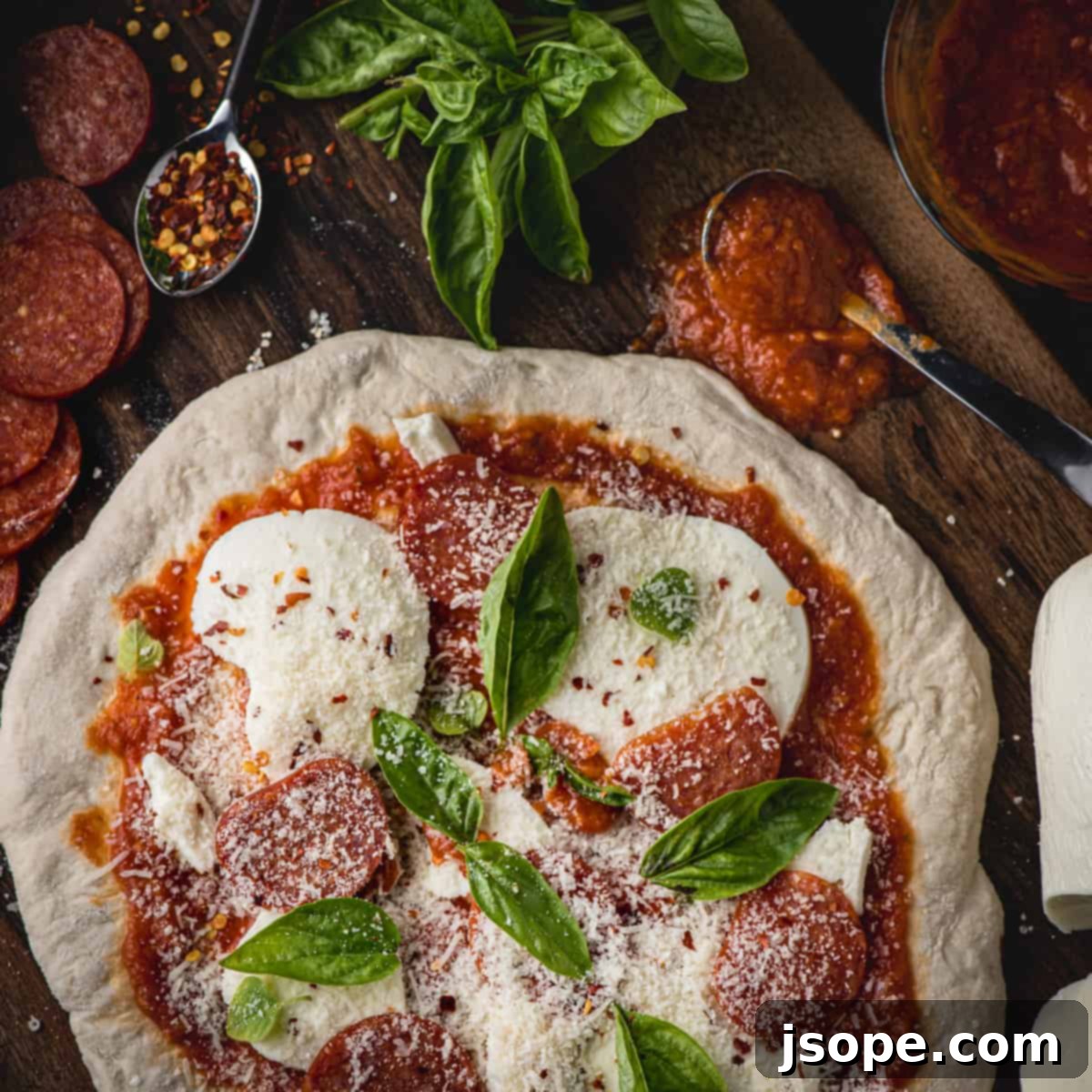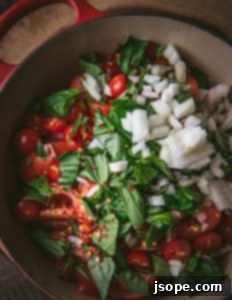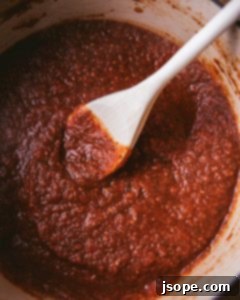The Secret to an Unforgettable Slice: Crafting the Best Homemade Pizza Sauce
Why embark on the journey of making pizza sauce from scratch when countless options are just a phone call away? The answer, unequivocally, lies in an experience that transcends mere convenience. Homemade pizza sauce isn’t just superior in taste; it’s a sensory delight that transforms your kitchen into a bustling Italian trattoria, filling your home with an aroma that whispers of sun-drenched Tuscan villas. This isn’t just about food; it’s about an authentic culinary adventure, and the best homemade pizza sauce is your passport to that very essence of Italy.
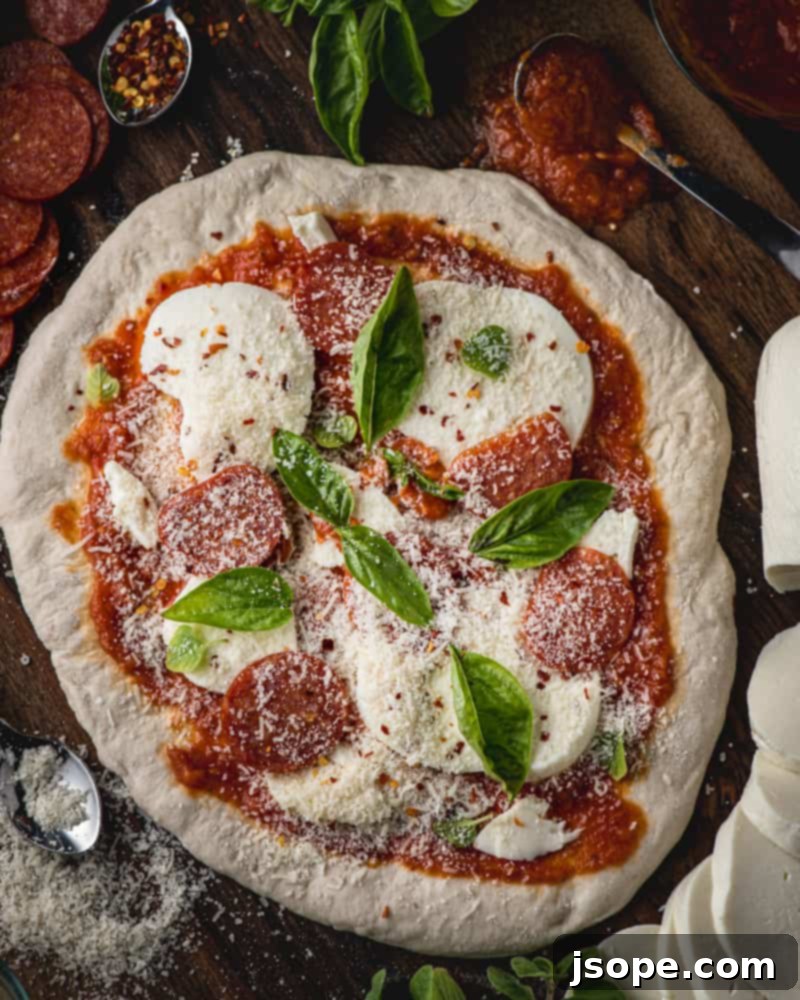
Why Make Pizza at Home? Beyond the Sauce
While the sauce itself is a game-changer, making pizza at home is a wonderfully engaging activity for the whole family. It’s a fantastic way to bond, especially with children, as everyone gets to unleash their creativity, customizing their pies with an array of toppings. Imagine the joy on their faces as they craft their own edible masterpieces!
In a world dominated by processed foods, the satisfaction of creating something from scratch is unparalleled. Homemade items, almost without exception, outshine their store-bought counterparts, and pizza sauce is a prime example. The process isn’t overly complicated, and the rewards, in terms of flavor and freshness, are truly infinite. You’re not just cooking; you’re cultivating an experience.
The true magic of homemade sauce lies in your ability to control and fine-tune every ingredient. This level of customization allows for dramatic shifts in flavor profiles. Consider the choice between fresh basil and dried oregano – each imbues the sauce with a distinct character. Fresh garlic versus none at all, a subtle heat or a fiery kick, sweet or savory undertones – every decision is yours to make. Even the type of tomatoes plays a pivotal role, with different varieties offering unique sweetness, acidity, and depth. This mastery over ingredients ensures your pizza sauce is perfectly tailored to your palate.
Homemade Pizza Sauce vs. Store-Bought: A Clear Winner
The primary, perhaps only, advantage of store-bought pizza sauce is its sheer convenience. However, this pales in comparison to the myriad benefits of crafting your own. As previously highlighted, homemade sauce offers a superior flavor advantage, but it also empowers you to adjust the intensity and richness to your exact preference. Do you prefer a robust, deeply flavored sauce or something lighter and brighter? The choice is entirely yours.
Crucially, when you make your own pizza sauce, you have complete transparency regarding its contents. You’re liberated from the hidden preservatives, excessive sugars, and artificial additives that often lurk in pre-packaged products. Every ingredient is carefully selected by you, ensuring a healthier, purer product. For those mindful of dietary needs, such as low-sodium diets, homemade sauce is a revelation. You can drastically limit the salt content without compromising on taste, proving that healthy eating doesn’t mean sacrificing flavor.
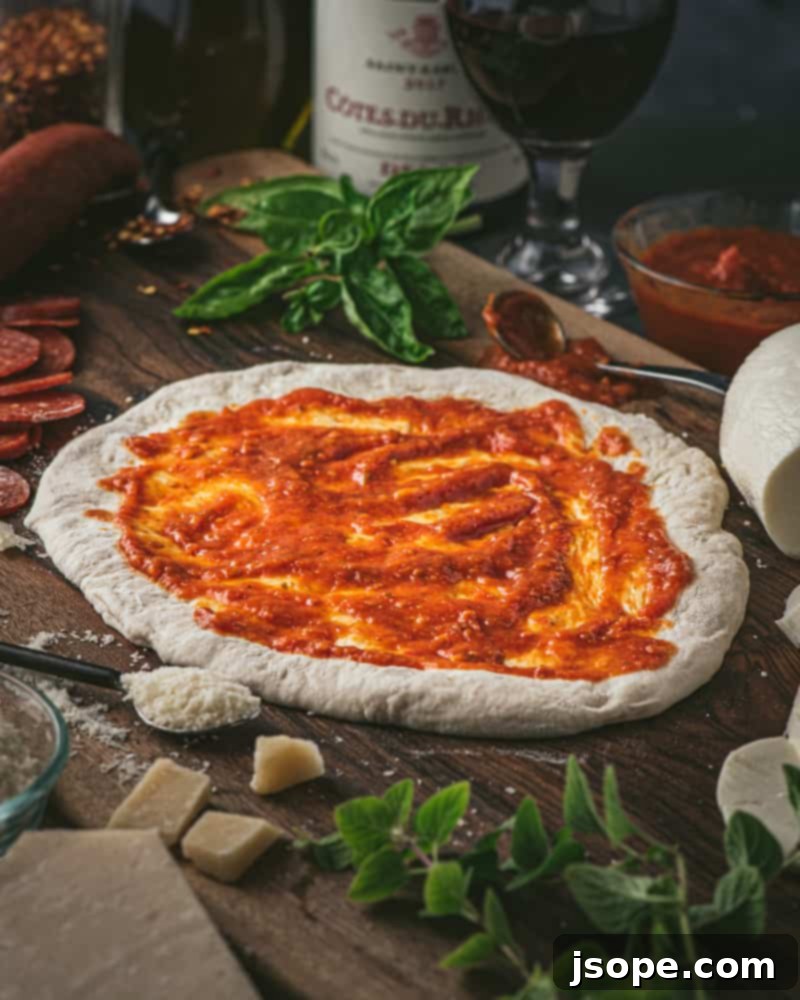
What is the Best Consistency for Homemade Pizza Sauce?
The ideal homemade pizza sauce should boast a rich, deep flavor and a consistency akin to a well-balanced ketchup. It needs to be pourable, yet substantial enough to cling to the dough without being watery. This balance is key to achieving pizza perfection.
While personal preference is always paramount, be cautious about making your sauce too thin. A watery sauce can quickly saturate the pizza dough, leading to an undesirable soggy crust – a common pitfall for homemade pizza makers. However, if a thinner sauce is genuinely your preference, don’t let conventional wisdom deter you; it’s your pizza, after all, and culinary exploration is encouraged!
Conversely, a sauce that’s overly thick, resembling tomato paste, often lacks the complex flavor nuances we strive for. Extreme concentration can mute the delicate notes of herbs and fresh tomatoes. If you prefer a thicker style, simply allow your sauce to reduce a bit more, but remember to taste frequently throughout the cooking process. The beauty of homemade sauce is its dynamic evolution; flavors deepen and meld over time, making constant tasting not just a recommendation, but a necessity to achieve your desired profile.
Should you accidentally reduce your sauce too much, don’t despair! A small amount of water or vegetable broth can be added back in, gradually, to thin it to your preferred consistency. This flexibility is another testament to the forgiving nature of cooking from scratch.
How Do You Thicken Pizza Sauce Naturally?
Achieving the perfect viscosity for your pizza sauce doesn’t require complex techniques or thickening agents. The primary method is simple reduction. By simmering your sauce gently over low heat, you allow the excess moisture to evaporate, naturally concentrating the flavors and thickening the consistency. This patient process is fundamental to a deeply flavored sauce.
Mid-way through the simmering process, roughly after one-third of the cooking time, I highly recommend blending the sauce. An immersion blender is ideal for this, allowing you to achieve a smooth, uniform texture directly in the pot. This eliminates the need for any starches or artificial thickeners, ensuring the sauce’s natural richness shines through. The key is consistent stirring; without it, the sauce can burn at the bottom, irrevocably compromising all the beautiful flavors you’ve worked so hard to develop. Patience and attentiveness are your best friends in this stage.
Our recipe suggests an estimated cooking time of about 3 hours. However, consider this a guideline rather than a strict rule. The actual time will depend on factors like the water content of your tomatoes and the heat of your stove. Keep a close eye on your sauce, stirring occasionally, and when it reaches your desired consistency and flavor, it’s done! Take note of the sauce’s performance on your finished pizza – was it perfect? Too thick? Too thin? These observations will guide your adjustments for next time, refining your recipe with each batch.
Can I Make Pizza Sauce Ahead and Freeze It?
Absolutely! In fact, we highly encourage it. Our recipe yields a generous quantity, enough for 2-3 delightful pizza dinners, depending on the size of your gathering. This makes homemade pizza sauce a fantastic meal prep component. To store, simply allow the freshly cooked sauce to cool completely to room temperature before transferring it to freezer-safe containers or bags. This prevents ice crystal formation and preserves the sauce’s quality.
When you’re ready to use it, remove the sauce from the freezer and let it defrost on your kitchen counter until it reaches room temperature. Then, gently reheat it in a saucepan over low heat, stirring occasionally. This convenience ensures that even on busy weeknights, the incredible flavor of homemade pizza is always within reach.
What is the Difference Between Pizza Sauce and Spaghetti Sauce (Pasta Sauce)?
The culinary world sometimes debates the precise distinction between pizza sauce and pasta sauce. Some schools of thought suggest that traditional pizza sauce is often uncooked, relying solely on the fresh flavors of tomatoes, while pasta sauce is typically cooked. While you can certainly experiment with raw pizza sauces – and there are delicious recipes out there for those who prefer that style – our recipe firmly advocates for a cooked sauce, precisely because we believe it delivers a superior depth of flavor and texture that truly elevates a pizza.
For us, the primary difference boils down to two key aspects: thickness and consistency. Pizza sauce should be smooth and relatively thick, designed to cling to the dough without making it soggy. It should complement, not overwhelm, the other toppings. Pasta sauce, on the other hand, often welcomes a chunkier texture, with visible pieces of tomato, onion, or other vegetables, and can be slightly thinner as it’s meant to coat pasta strands.
Ultimately, the beauty of homemade cooking is that you can adapt any sauce to your pizza. Nobody will be harmed by your culinary choices! The true criteria for success are taste and texture. Regardless of the sauce’s origin or style, a limp, waterlogged dough is a culinary catastrophe that even the most exquisite toppings cannot redeem. Focus on achieving a vibrant flavor and a consistency that supports a perfectly crispy crust.
How We Make a Better Pizza Sauce: Expert Tips
While the recipe below provides a solid foundation, certain techniques and ingredient choices can elevate your homemade pizza sauce from great to absolutely extraordinary. We’ve touched on taste preferences, but here are some non-negotiable steps that will consistently improve your sauce.
Seed the Tomatoes for Purer Flavor
Our first crucial tip: seed your tomatoes. While peeling them is optional (especially if you plan to blend the sauce, as the skins will be pulverized), removing the seeds is vital. Tomato seeds contribute excess moisture and can introduce a slightly bitter flavor, as well as an undesirable grainy texture, detracting from the silky smoothness you want in a quality pizza sauce. A simple scoop with a spoon or your fingers is all it takes to make a significant difference.
Embrace the Richness of Roma Tomatoes
For the best baseline flavor, we highly recommend using Roma (also known as plum) or heirloom tomatoes. These varieties are typically meatier, contain fewer seeds, and boast a lower water content compared to other tomatoes, leading to a richer, more concentrated sauce. A combination of Roma and heirloom can offer a fantastic balance of sweetness and depth. Additionally, incorporating a handful of sweet cherry tomatoes can inject a wonderful burst of freshness and natural sweetness, brightening the overall flavor profile. If possible, source your tomatoes from a local farmer’s market or grow them yourself; the difference in flavor between freshly picked, locally grown tomatoes and supermarket varieties is profound and will significantly impact your final sauce.
Achieve Smoothness with an Immersion Blender
An immersion blender is an invaluable tool for pizza sauce making. It allows you to effortlessly achieve a beautifully smooth, uniform consistency without the hassle of transferring hot sauce to a traditional blender and back. If you don’t own an immersion blender, a standard blender will work, but exercise extreme caution when blending hot liquids. Hot steam can build pressure inside a sealed blender, potentially causing the lid to burst. Always start with small batches, vent the lid, and cover it with a kitchen towel to prevent splatters. Trust us, cleaning pizza sauce off your kitchen walls and ceiling is not a fun task!
Dare to Experiment with Flavors
Once you’ve mastered the basic recipe, don’t be afraid to experiment! There’s no single “right” or “wrong” way to make pizza sauce, only what tastes best to you. While tradition offers a wonderful starting point, culinary innovation can lead to delightful discoveries. Feel free to adjust herbs, spices, and even add unexpected (but complementary!) ingredients. Common sense, however, should always prevail. As much as I (Mark) adore crunchy peanut butter, it will never find its way into my pizza sauce. Ever. Find your unique signature, but keep it within the realm of delicious.
The Unrivaled Vibrancy of Fresh Herbs
Finally, and perhaps most importantly, fresh herbs are unequivocally superior to dried herbs in pizza sauce. While dried herbs have their place, fresh basil, oregano, and marjoram bring a vibrant, aromatic complexity that dried versions simply cannot replicate. The difference is akin to night and day. If you’ve never conducted a side-by-side comparison, we urge you to try it. You’ll quickly discover that the bright, peppery notes of fresh basil or the earthy aroma of fresh oregano make an enormous impact, infusing your sauce with an unparalleled liveliness. Trust us on this; it’s a game-changer.
View this post on InstagramA post shared by Cooking With Wine Blog (@cooking_with_wine)
Crafting the Perfect Pizza Dough
A truly exceptional pizza begins with outstanding dough. While countless fantastic recipes exist, we have a wonderfully simple and quick 1-hour pizza dough recipe that you can easily whip up at home right here. This recipe is a testament to how uncomplicated homemade dough can be, requiring just a few basic ingredients: flour, commercial yeast, water, salt, and a touch of olive oil. Seriously, don’t even think about buying pre-made dough! Once you experience the ease and superior taste of homemade, you’ll wonder why you ever bothered with store-bought options. Trust us on this; your taste buds will thank you profusely.

What Should I Put on My Pizza? Thoughtful Topping Suggestions
While the beauty of pizza lies in its versatility – you truly can put whatever your heart desires on it – a little thoughtful consideration for topping pairings can elevate your pizza from good to gourmet. The choice of herbs in your sauce, for example, can dictate the best complementary toppings.
For instance, a sauce rich with oregano pairs exceptionally well with robust meats like Italian sausage or pepperoni. If your palate leans towards a classic Italian sausage pizza, an oregano-forward sauce will create a harmonious flavor profile. Conversely, for a traditional Margherita pizza, where the focus is on fresh, bright flavors, basil should be your herb of choice, or you might even opt for no herbs at all in the sauce, allowing the fresh basil leaves added post-bake to shine. Remember, there’s no strict right or wrong, but these subtle considerations can make a significant difference. Here are a few essential tips to guide your topping choices:
Pizza Topping Tips and Suggestions for an Elevated Experience
- **The Classics are Classic for a Reason:** Your base ingredients typically include quality dough, your incredible homemade sauce, fresh mozzarella, and a sprinkle of basil or oregano. For protein lovers, thinly sliced pepperoni or Italian sausage (hot or sweet, to your liking) are timeless additions that offer satisfying savory notes. Don’t overthink it; trust your preferences and build from there!
- **Less is Often More: The Art of Simplicity:** The most memorable pizzas I’ve ever tasted or made adhere to a simple philosophy: a superb dough, an exquisite sauce, quality cheese, and perhaps one or, at most, two additional toppings. Piling on four or more toppings can create a cacophony of flavors, often masking the delicate nuances of your painstakingly crafted sauce and dough. Allow each ingredient to shine individually.
- **Combatting the Soggy Crust: Dehydrate Your Tomatoes:** If fresh tomatoes are among your preferred pizza toppings, a clever trick to prevent a soggy crust is to lightly dehydrate them in the oven beforehand. Sliced tomatoes can release a significant amount of moisture during baking, which can seep into the dough. A brief stint in a low oven will remove this excess water, ensuring your crust remains perfectly crisp and delightful.
- **Cheese: Quality Over Quantity:** Everyone loves cheese, but an excessive amount can actually detract from the pizza experience. It can overwhelm the other flavors and make the pizza feel unpleasantly heavy. A pizza dough that buckles under the weight of its toppings often signifies a less-than-ideal American chain takeout experience – and if that’s your preference, then perhaps this artisanal guide isn’t quite for you! Aim for a balanced distribution that complements, rather than dominates.
- **Finishing Touches: Parmesan and Red Pepper:** A generous sprinkling of freshly grated Parmigiano Reggiano (the real deal, not the pre-grated kind that lacks true flavor) or, if you prefer a sharper, saltier kick, Pecorino Romano cheese, added immediately after the pizza comes out of the oven, can add incredible depth and umami. A pinch of crushed red pepper flakes introduces a subtle warmth and a welcome zing. These finishing touches genuinely elevate any pizza.
- **Venture Beyond the Expected: Unique Flavors:** Don’t be shy about exploring unconventional yet delicious toppings. A few lesser-known but highly recommended options include fragrant fennel seeds, tender roasted garlic cloves that melt in your mouth, or savory strips of prosciutto added after baking for a delicate texture and salty kick. These ingredients can transform a standard pizza into an gourmet delight.
For those seeking even more unique and adventurous options, be sure to explore our recipes for Truffle Mushroom White Pizza or our delightful Goat Cheese Pesto and Asparagus Pizza!
How to Cook Homemade Pizza for the Perfect Crisp
The secret to a perfectly cooked homemade pizza, with a gloriously crispy crust and beautifully melted cheese, can be summarized in one word: HOT. The hotter you can get your cooking surface and environment, the better your pizza will be. Our two favorite methods for achieving this optimal heat and texture are cooking on a preheated pizza stone in the oven or directly on a hot grill.
Mastering the Oven with a Pizza Stone
Our detailed recipe card includes comprehensive instructions for cooking your pizza in the oven, whether you’re using a dedicated pizza stone or a standard baking pan. If you’re utilizing a pizza stone, which we highly recommend for achieving that coveted brick-oven crispness, the most crucial step is thorough preheating. Place your pizza stone on a rack in the upper third of your oven and preheat the oven to its absolute highest temperature setting (often 450°F or higher). Allow the stone to heat for at least 30 minutes *after* the oven has reached its set temperature; this ensures the stone absorbs and radiates maximum heat, which is essential for rapidly cooking the crust.
For the very best results, assemble your pizza immediately before it goes into the oven. Avoid letting an assembled pizza sit for too long, as the moisture from the sauce and toppings can begin to hydrate the dough, leading to a less crispy result. We recommend assembling your pizza directly on a lightly floured or semolina-dusted pizza peel. This allows for a smooth, swift transfer of the pizza directly onto the scorching hot stone in the oven, ensuring an instantaneous crisping of the crust. Delaying the transfer by even a few minutes can expose the dough to unnecessary moisture, compromising its texture.
Finally, if you are fortunate enough to own a custom pizza oven, you are undoubtedly already a pizza master, and we are genuinely surprised you’ve read this far (unless, of course, you’re merely enjoying our detailed ramblings!).
The Charred Perfection of Pizza on the Grill
Grilling pizza is an incredibly rewarding and surprisingly easy method that imparts a unique smoky flavor and delightful char to the crust. Begin by ensuring your grill grates are clean and lightly oiled to prevent sticking. Ignite your grill and allow it to get as hot as possible. Once searing hot, carefully place your raw pizza dough directly onto the grates for about a minute. This initial blast of heat will cook and firm up the bottom of the crust. Quickly flip the dough, then, with great speed, add your homemade sauce and desired toppings to the pre-cooked side. Close the grill lid immediately, and within another minute or two, your pizza should be perfectly cooked.
To check for doneness, discreetly peek at the bottom of the crust – it should have inviting dark brown spots, and perhaps even a few very dark, slightly charred spots, which contribute wonderful flavor. Your sense of smell will also be a reliable guide; a delicious, toasty aroma is a good indicator that your pizza is ready to be devoured.
Enjoy Your Homemade Masterpiece!
Good luck with your pizza-making endeavors, and buon appetito! We hope this guide inspires you to create truly unforgettable homemade pizzas. If you try out our recipe or any of these tips, we’d love to hear from you. Leave us a comment below or tag us on Instagram @cooking_with_wine to share your delicious creations.
Discover more Italian favorites and expand your culinary repertoire:
- Summer Pasta (Pasta D’Estate)
- Homemade Pasta Recipes: Make It Today
- The Best Homemade Shrimp Scampi Recipe
- Italian-Style Meatloaf
📖 Recipe: The Best Homemade Pizza Sauce

The Best Homemade Pizza Sauce
10 mins
3 hrs
3 hrs 10 mins
Dinner, Lunch
Italian
10 pizzas
285 kcal
Ingredients
- 10 Roma tomatoes, cracked
- 2 pints cherry tomatoes, halved
- 1 small onion, diced
- ¼ cup water
- 1 teaspoon kosher salt
- 1 bunch of basil (rough chopped)
- ¼ cup oregano leaves
- 1 teaspoon crushed red pepper flakes
- 1 tablespoon good quality extra virgin olive oil
- Kosher salt to taste
1-hour Pizza Dough** (makes about 4-5 personal pizzas)
- 1 cup (237ml) warm water
- 1 teaspoon honey
- 2 ¼ teaspoon active dry yeast
- ½ cup (65g) olive oil
- 3 cups (408g) all purpose flour
- ¼ teaspoon salt
- 1 tablespoon Italian herbs, dry
Instructions
- Add tomatoes, onion, water, salt, basil, oregano and red pepper flakes to a dutch oven/pot or large skillet. Cover and bring to a boil.

- Uncover and simmer, stirring occasionally until tomatoes break down fully and liquify. Be patient. This should take about an hour.
- Blend sauce with an immersion blender (should be consistency of pasta sauce at this point).
- Continue to reduce at a simmer until sauce thickens to a consistency between pasta sauce and tomato paste. This will take another 1-2 hours.

- Add olive oil and salt to taste.
- Add more herbs or red pepper flakes if desired. Let cool and store overnight to concentrate flavors further.

1 hr Pizza Dough (makes 4-5 personal pizza crusts)
- To make the 1-hr dough, in the bowl of a stand mixer with a dough hook (or in a large bowl to mix by hand), add the honey and warm water and mix. Sprinkle the yeast on top and let it sit for 5-10 minutes until it begins to bloom and appear foamy.
- Next, add the oil, flour, salt and herbs and begin mixing on medium. Mix until the contents are completely incorporated and the dough forms a smooth ball around the hook (alternatively, mix by hand and knead on a lightly floured surface until smooth).
- Form the dough into a fairly tight ball and drizzle a small amount of olive oil into a large bowl. Add the dough ball to the bowl, cover with plastic wrap and set aside. Place the bowl in a warm place, such as an oven with the light on, until the dough has doubled in size (this will take about 1 hour).
- Once doubled, punch the dough down and divide into individual balls for each crust. When ready, press your dough into a round crust to your preference of thickness.
Cooking Pizza
- Using a pizza stone is your best bet for making pizza. If you have one, place the pizza stone on a rack in the upper third of your oven and set your oven temp to as high as it will go (e.g., 450°F+). Once the oven reaches the temp, continue to let the pizza stone heat for 30 minutes while you prepare your other ingredients.
- When you are ready to cook your pizza, turn your oven to broil for 5 minutes, then add your toppings to your pizza. Before putting your pizza in the oven, turn the oven back to bake at the highest temp (e.g., 450°F+) and slide the pizza right onto the pizza stone using a pizza peel.
- Bake for 5-7 minutes, or until the crust begins to brown, then turn your oven back to broil and broil for another 1-2 minutes, or until the crust browns slightly more.
- If you do not have a pizza stone, preheat your oven to the highest temp, and place your pizza on a heavy duty baking sheet or round pizza pan and bake for the recommended time above. You may need to add a few additional minutes of baking depending on your oven temp, but check your pizza at the 5-7 minute mark and add a few additional minutes as necessary before broiling for 1-2 minutes.
- Remove your pizza from the oven and add any additional toppings (e.g., parmesan) slice and serve.
Nutrition
Carbohydrates: 38g
Protein: 6g
Fat: 13g
Saturated Fat: 2g
Polyunsaturated Fat: 2g
Monounsaturated Fat: 9g
Sodium: 310mg
Potassium: 439mg
Fiber: 4g
Sugar: 5g
Vitamin A: 1110IU
Vitamin C: 31mg
Calcium: 54mg
Iron: 3mg
classic Italian recipes, pizza, pizza sauce, tomato sauce
